The Samsung 750 EVO (120GB & 250GB) SSD Review: A Return To Planar NAND
by Billy Tallis on April 22, 2016 8:00 AM ESTAnandTech Storage Bench - The Destroyer
The Destroyer is an extremely long test replicating the access patterns of very IO-intensive desktop usage. A detailed breakdown can be found in this article. Like real-world usage and unlike our Iometer tests, the drives do get the occasional break that allows for some background garbage collection and flushing caches, but those idle times are limited to 25ms so that it doesn't take all week to run the test.
We quantify performance on this test by reporting the drive's average data throughput, a few data points about its latency, and the total energy used by the drive over the course of the test.
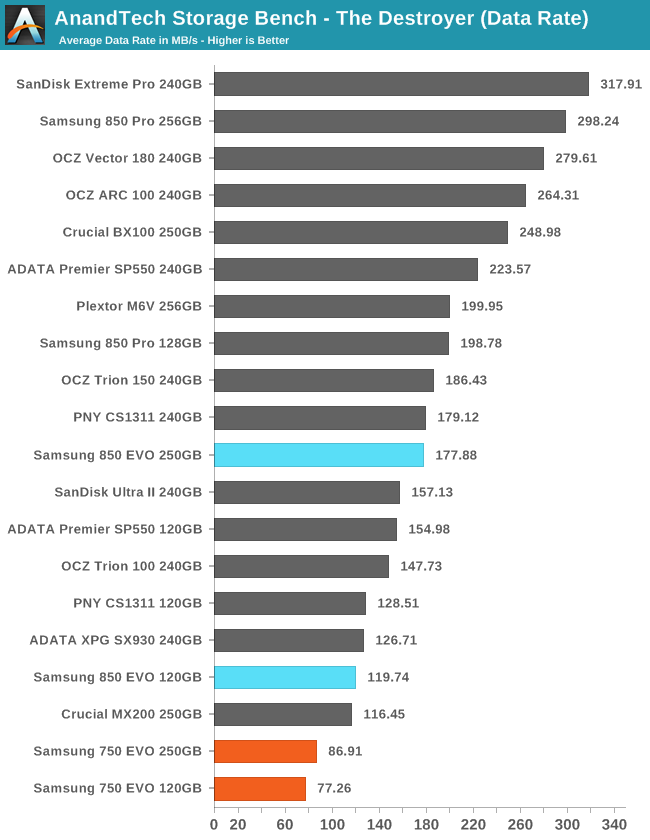
The Destroyer has earned its name here. The 750 EVO is clearly the slowest modern SSD on this test, showing that it is not suitable for sustained intense workloads with a high volume of writes. Almost any other SSD currently on the market will perform better under pressure, including competing TLC drives.
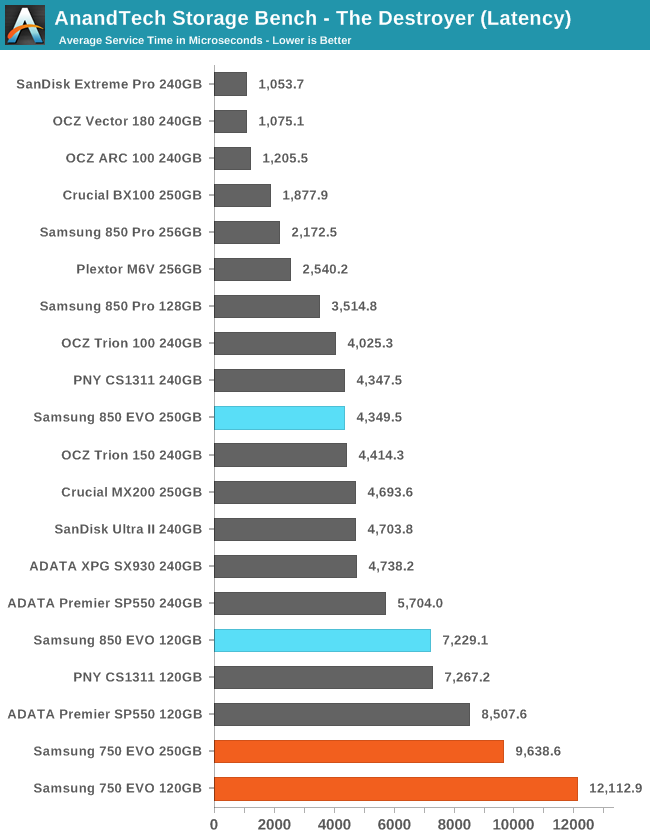
The 750 EVO also sets new records for slow responses, with average service times on par with standard hard drive seek times. Though since The Destroyer has an average queue depth of about 5.5, a mechanical hard drive would still be several times worse by this metric. Conversely, the best MLC SSDs are almost ten times quicker than the 750 EVO.
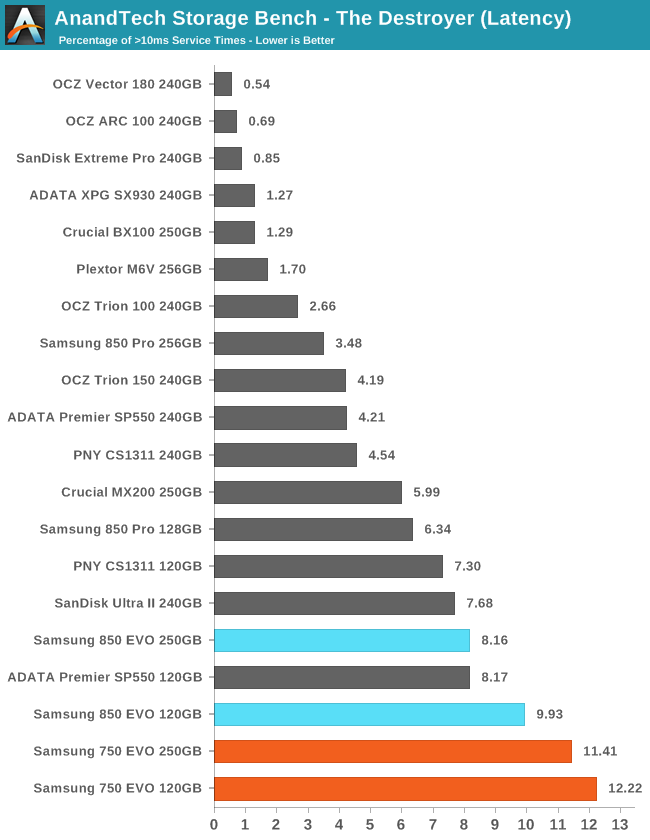
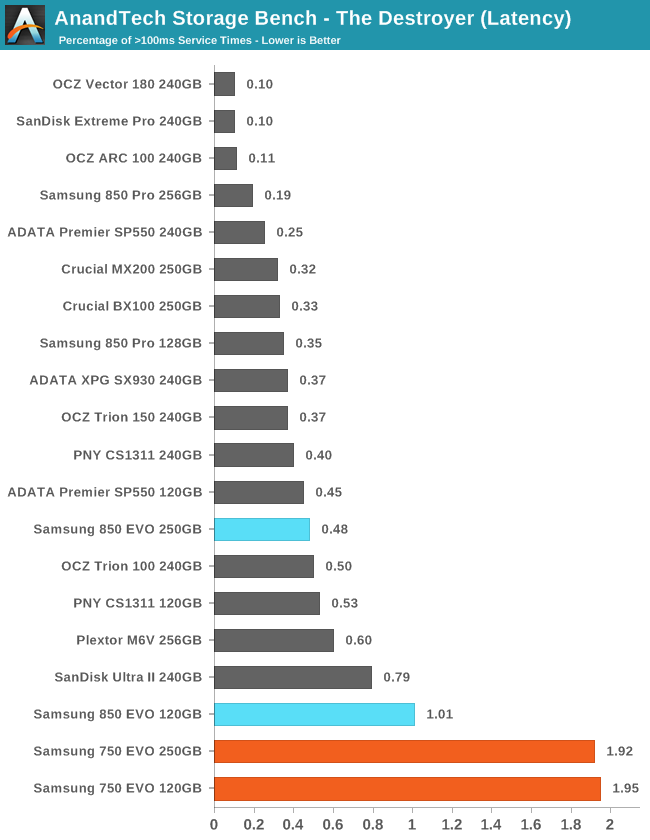
With over 10% of operations taking more than 10ms, we can't quite refer to them as outliers anymore. At the 100ms threshold, the 750 EVO has twice as many outliers as anything else.
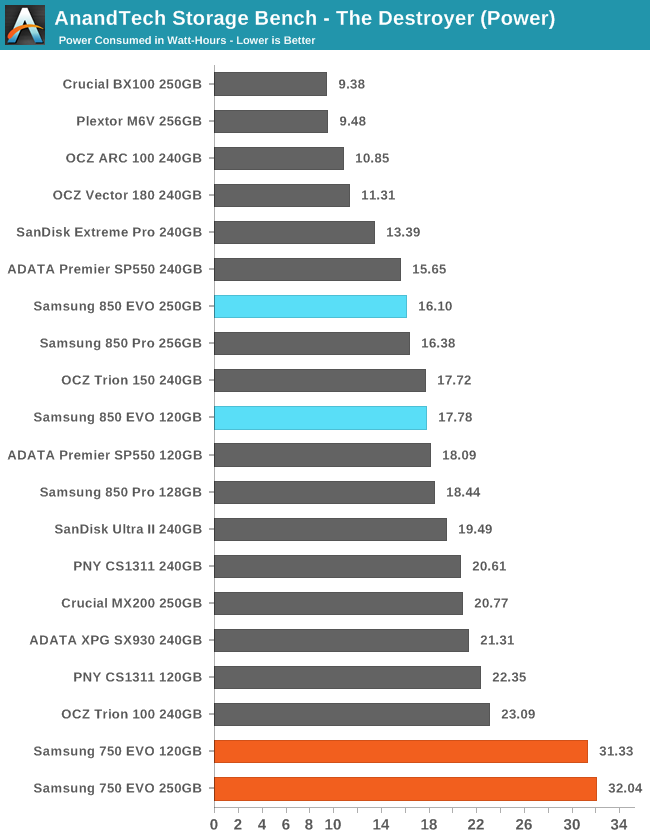
The substantially higher energy usage of the 750 EVOs is a straightforward consequence of them taking much longer than everything else to complete the test: The 120GB 750 EVO took just over 17 hours to complete this test while the 120GB PNY CS1311 took only 13.5 hours and the 128GB 850 Pro needed only 10 hours.










109 Comments
View All Comments
Bleakwise - Sunday, April 24, 2016 - link
I apologize for being rude but that's just not what they are made for. Paying 1,000$ for a 2tb NVME SSD just for cold storage is a lot like buying a 500,000$ super-car just to drop your kids off at school....Bleakwise - Sunday, April 24, 2016 - link
More like even up to 8k.A mechanical hard drive will roll out 150-200 GigaBYTES per second sequential read. 4k video is like 5 megaBYTES per second max. 8k would be 20, 16k would be 80. This is on h264, h265 will cut these in half, so you could watch a 32k video on something like a WD black.
I suppose if you wanted to play back something in 64k resolution you'd need an SSD though, at least until CPU/GPU tech makes h266 or h267 codec or whatever available.
Bleakwise - Sunday, April 24, 2016 - link
To be clear. The only reason content creators need NVME drives for 4k is because they work in uncompressed or intermediate formats. They need NVME drives for the same reason that a 4k bitmap is like 22 megabytes while the JPEG is just one or two.Eden-K121D - Sunday, April 24, 2016 - link
I think You meant MegaBYTES otherwise your hypothetical disk would be faster than anything on this planet LOLslowdemon21 - Friday, April 29, 2016 - link
SeaGate barracuda 195 MegaBytes per secBrokenCrayons - Friday, April 22, 2016 - link
Between the OS and software, my Windows desktop is currently using about 110GB of a 250GB hard drive. I don't game much, but there are handful of titles loaded on that system and I haven't exactly been working very hard at keeping my drive clean.On my primary computer (the desktop is more a network appliance than a day-to-day workstation as it runs headless now thanks to a combination of Steam in home streaming and VNC), a laptop with a 60GB SSD, there's about 35GB of free storage capacity, but the OS footprint is a lot smaller since it's a Linux box.
Granted, games are getting larger and a few newer titles I'm likely to play in the next year or so will make it necessary to start looking at more storage, but 250GB seems perfectly reasonable right now.
jabber - Friday, April 22, 2016 - link
Yeah just running 80GB of the 250GB 850EVO in my workstation. Having masses of software and data hanging around on a mchine seem crazy to me. Each to their own. However, most customers I see struggle to go over 60-70GB.bji - Friday, April 22, 2016 - link
This is because you guys don't pirate tons of movies and hoard them on SSD drives like some people who then complain about the cost of the media they use to store their pirated goods. I don't either, which is why the 250 GB SSD in my macbook pro is still only half full after nearly 4 years of use.bji - Friday, April 22, 2016 - link
BTW complaining about the cost of storage for pirated goods is like the ultimate douchebaggery imagineable. Not only are you ripping off people who worked to create the content you've pirated, you want to complain about how much money you have to pay to companies to produce the storage that you need to store it.StrangerGuy - Friday, April 22, 2016 - link
That's not ultimate pirate douchebaggery, it would be complaining why pirated videos are no longer available in Xvid because everybody should cater to people with decade old DVD players.